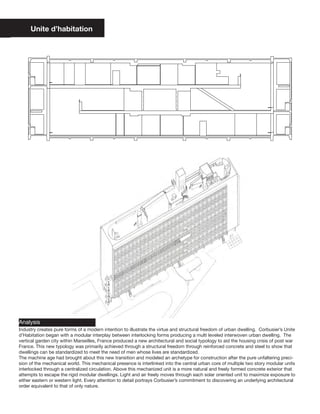
Atlas: Unitéhab+habitat67
- 1. Unite d’habitation Analysis Industry creates pure forms of a modern intention to illustrate the virtue and structural freedom of urban dwelling. Corbusier’s Unite d’Habitation began with a modular interplay between interlocking forms producing a multi leveled interwoven urban dwelling. The vertical garden city within Marseilles, France produced a new architectural and social typology to aid the housing crisis of post war France. This new typology was primarily achieved through a structural freedom through reinforced concrete and steel to show that dwellings can be standardized to meet the need of men whose lives are standardized. The machine age had brought about this new transition and modeled an archetype for construction after the pure unfaltering preci- sion of the mechanical world. This mechanical presence is interlinked into the central urban core of multiple two story modular units interlocked through a centralized circulation. Above this mechanized unit is a more natural and freely formed concrete exterior that attempts to escape the rigid modular dwellings. Light and air freely moves through each solar oriented unit to maximize exposure to either eastern or western light. Every attention to detail portrays Corbusier’s commitment to discovering an underlying architectural order equivalent to that of only nature.
- 2. Unite d’habitation Photo Here Photo Here Photo Here Scale 1/32” = 1’-0” In Section Scale 1/128” = 1’-0” In Plan (Site)Plan Here Architect Le Corbusier City / Location Marseille, France Year Designed / Built 1947 /1952 Area, # Floors, # Units Area: 386,130sq ft Floors: 12 Units: 366
- 3. Unite d’habitation Part-Whole Relationships Thresholds + Porosity Light + Transparency Access + Circulation
- 4. Unite d’habitation Structure + Systems Collective Infrastructure Urban Connections
- 5. Habitat 67 Analysis Habitat 67 was designed by Moshe Safdie in Montreal Canada, for Expo 67. The prefabcricated module used in this design was a basic rectangle that measured 17 feet by 38 feet by 10 feet high. Vertical circulation is by three elevator cores spaced evenly throughout the complex. What helps create a sense of community as well as access to private individual apartments and public community spaces are a series of horizontal walk ways called “pedestrian streets”, on every thrid level. The efficiency of the retangular modules allow them to carry all of the structural loads, they are connected to each other by using high-tension rods, cables, and weld- ing allowing for a continous structure. The offseting of the module is a technique used that created semi private roof gardens for each module. Large voids between the housing clusters allow for light and air to pass through. The original design for Habitat 67 consisted of a 22-story section with a toal of 1,200 housing units, 350 room hotel, two schools, and a neighborhood shopping area. Only 158 units where built.
- 6. Habitat 67 Photo Here Photo Here Photo Here 1 2 5 4 3 4 5 5 1 4 4 5 1 3 Bedroom Unit 3 5 1 2 Bedroom Unit 1/16” = 1’ Architect Moshe Safdie City / Location Montreal / Canada Year Designed / Built 1961 / 1967 Area, # Floors, # Units 1 BR 600 sqft/4 BR 1800 sqft # 12 # 158 Plan Key Unit Plan Key 1 common 1 live 2 unit 2 eat 3 cook 4 sleep 5 bathe
- 7. Habitat 67 Part-Whole Relationships Thresholds + Porosity Light + Transparency Access + Circulation
- 8. Habitat 67 Structure + Systems Collective Infrastructure Urban Connections
